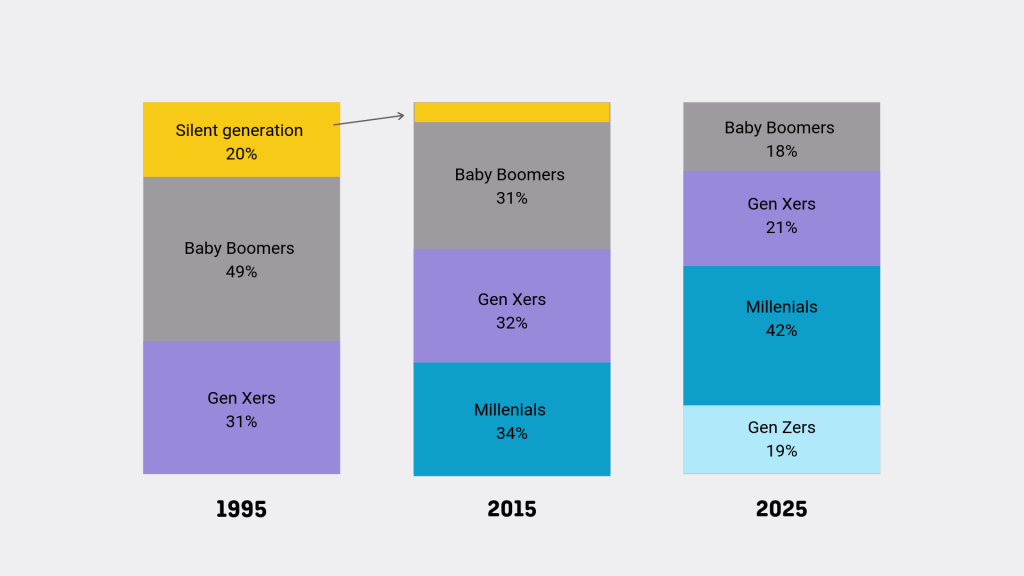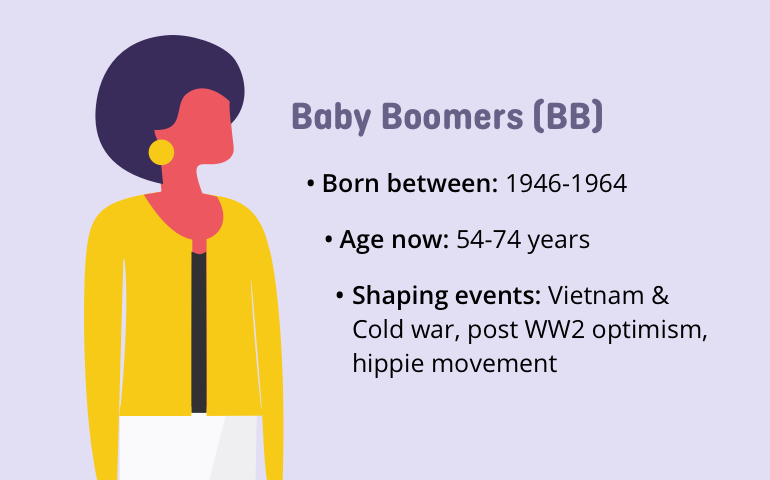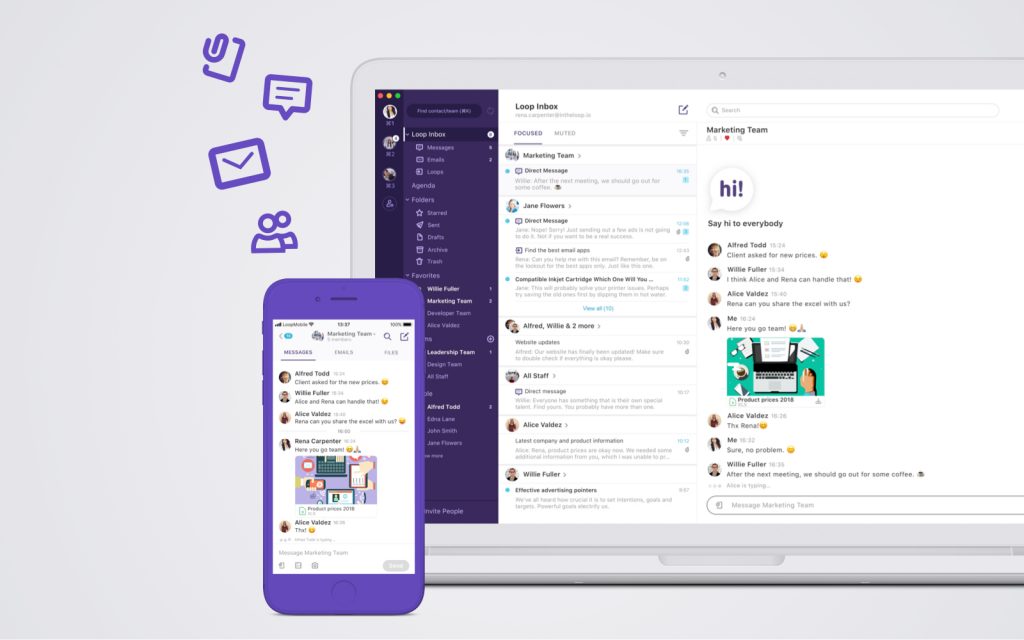Today’s workplace is increasingly becoming an interesting mix. In the office, we meet people from different beliefs, cultural backgrounds, interests and ages. And whilst all these areas are interesting to explore, in this article, we will be focusing on age.

Yep, we’re talking about the well-known generations, for example, Baby Boomers, Gen X, Millennials, Gen Z. As we live and work longer, it’s not unusual anymore to have a sales manager twice the junior developer’s age, for example. This mix comes with a set of challenges – possible disagreements, a difference of opinions, tech-savyness etc.
Nevertheless, the differences between them can also be beneficial. Research and empirical evidence
This may not be news for many people in non-business fields as many have already taken steps towards connecting the different generations:
- Germans, for example, are big fans of the concept of generational diversity and have built the
so called Mehrgenerationenhaus (literally multigenerational houses) all over the country where people of different ages come together and enjoy the fruits of intergenerational interactions. - Another successful idea brought to life almost was years ago is Slovenia’s “Symbiosis between generations” (Simbioza), where Millennials and Gen Z youth helps the elderly citizens (usually Baby Boomers or the representatives of the Silent Generation) learn digital skills. It’s a hugely successful program, connecting four generations that can all learn from each other.
»What we call a generation gap, is usually the
result of an interaction gap.« Source

How can we best manage people of different ages so that the age gap is not a problem, but rather a constructive force? Let’s first meet the generations that are working together today.
The three generations
All three generations are of course stereotypical descriptions of rather broad age groups (demographical cohorts) – that’s why you’ll find different years of birth that are supposed to define them and various descriptions of their main feats. Still, these characteristics can be very helpful at bridging the possible generation gap within your team.



We haven’t
How are they different and how can they best work together?
Below, we identify the three main areas where the representatives of the three generations differ from each other, offer some practical advice for bridging the generation gap and putting together a winning diverse team.
1. Attitude towards work
The Baby Boomers mimic the hardworking attitude of their parents, The Silent Generation, who was truly a work-centric society. Millennials mostly relate to the TGIF (Thank God it is Friday) mantra, while the Gen Xers tend to be self-focused at work and have a mindset of “every work is temporary and final”.
How to bridge the gap?
– Set up a mentoring programme where generational know-how can be shared. Karen, the Boomer in your team, can pass on the knowledge, useful contacts, and perspectives that she has developed during her multiple years within the company. In return, the new Millennial co-worker Mike can help her to get the grip with the latest social media revolution.
– Clarify the company’s workflow. Not everyone can sit behind the desk all day. Some find inspiration and ideas with the laptop on a beanbag! Set goals and expectations and make it clear that you’re not strict about the ways to achieve them and the locations. Let Karen, the BB, see there is nothing wrong if Millennial Mike works from home once a week, but make sure that Mike follows certain other traditional rules of conduct at the office.
– Different roles, same goal. The strength of every individual makes the team a well-oiled machine. For instance, if you are working on a new social media campaign, let Millennial Mike, who knows how to hashtag, explain it to a BB, whilst the Baby Boomer or a Gen Xer can provide insight on managing client feedback or proven communication strategies throughout the years.
2. Communication skills and digital literacy
BBs started their careers before computers were common, so face-to-face communication is their preference. Tech revolution, cell phones invention and first ever email being sent to the universe, defined the Gen Xers. And Millennials don’t need any special introduction to virtual communication as they grew up in its uprising phase and therefore tend to be social multi-taskers.
How to bridge the gap?
– Easier transition, better teamwork. As the workload increases and business is getting faster, it’s necessary to add some technological solutions to optimize work. We’re eternally grateful for apps that enable video conferencing, collaboration, and simple accounting. But adding too many apps to your workflow can be very stressful – especially for the older generations. That’s why collaboration apps, such as Loop Email are a great solution. They are built on email (to the Baby Boomer’s joy), but also incorporate chat messaging (Gen Xers are fine with it, Millenials love it) in a way that makes collaboration and teamwork easier and more efficient.

– Diverse communication styles. Let Millennial Mike teach the BBs or Gen Xers about more relaxed communication styles – like using emojis for short responses or giving their input about influencer marketing. On the other hand, allow BBs and Gen Xers to show proper business etiquette when communicating with high profile clients.
3. Values and preferences
Baby Boomers tend to be loyal to their company, highly valuing personal recognition or financial stability. Skeptical, cynical, and quick to question everything – The Gen Xers. They are global thinkers placing value on independence, recognition
How to bridge the gap?
– Show respect. We all need to feel respected in the workplace to stay engaged and motivated. Generation X considers time their most valuable resource, as being the “inventor” of work-life balance attitude. Show them respect by not overloading them with unnecessary meetings and limiting menial tasks to the minimum. BBs, on the other hand, feel respected when you give them a share of your time. They value one-on-one relationships and enjoy working with others. Millennials want to be part of the decision-making process; they feel respected when they feel

– Accept and reward. Acknowledge each generation’s values. A Gen Xer might want time off, BB may prefer a monetary bonus and a Millennial would love to attend a workshop or training. Ask your employees about what motivates them, then offer those incentives. Give people choices.
As John Izzo puts it:
“You have to understand the diversity in values. We grew up in different worlds but at the end of the day, we all want the same thing – to feel respected and valued.”

















Add comment